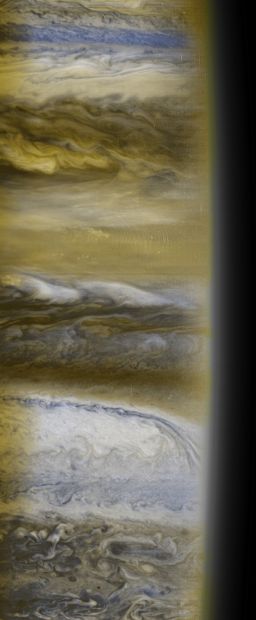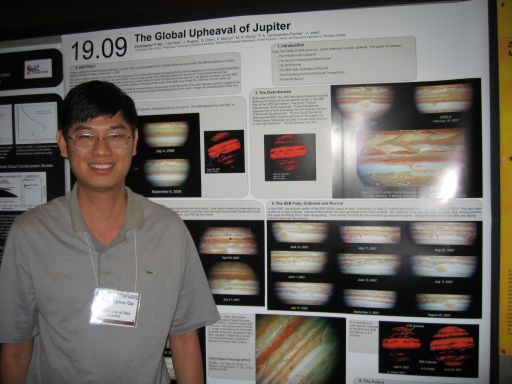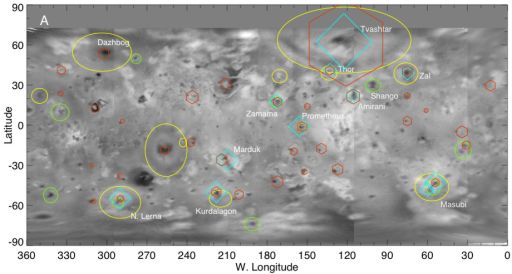Emily Lakdawalla • Oct 10, 2007
DPS: New stuff from New Horizons at Jupiter
I'm already on my way home from the Division of Planetary Sciences meeting in Orlando, which will continue there for the rest of this week. Overall, it was not quite as exciting as some of the previous DPS meetings I've been to. Most of the presentations were refinements or updates of things I've seen before, rather than new results; they were interesting, but not Earth-shattering.
A case in point was the New Horizons results from Jupiter; there was a special session yesterday (Tuesday) and the first scientific publications from the encounter are coming out in Friday's issue of the journal Science. But most of the stuff they presented -- spectacular though it is -- I had already seen at the icy satellites conference in Boulder in August (you can read about that here). There were a couple of new items, though
Amy Simon-Miller presented on "Jovian Winds and Waves from New Horizons." She showed various interesting features in the moving bands and belts of Jupiter's clouds, but some of the coolest were what she called "mesoscale gravity waves" near Jupiter's equator. They are like ocean waves in that the waves propagate through the medium of Jupiter's atmosphere with a speed that is different from the speed of the moving atmosphere itself. Their wavelength is small by Jupiter standards, only 300 kilometers from peak to peak, striping Jupiter's equator with a faint fishbone pattern. And they move fast -- by tracking wave features, Amy found that they move 100 meters per second faster than the atmosphere itself is moving. She found the waves in images taken by New Horizons' color imagers, MVIC and LEISA, in observations that were designed not for science but for instrument calibration; the science was a bonus.

NASA / JHUAPL / SwRI
Jupiter's cloud tops from New Horizons MVIC
This image was captured by MVIC, the color camera aboard New Horizons as it spe by Jupiter in February 2007. MVIC was designed to operate at Pluto's distance from the Sun, so most targets in the Jupiter system were too bright; this image was taken near the terminator (day-night boundary) and so shows the twilit cloud tops near the equator. Near the center of the image, a beige band of clouds exhibits a fish-bone pattern of "mesoscale waves" made visible by the glancing geometry of the sunlight.
NASA / JHUAPL / SwRI
Lightning near Jupiter's north pole
As New Horizons departed the Jupiter system, it turned back to survey its night side for lightning flashes, focusing on the poles. New Horizons spotted several flashes, including one active cloud that spawned two other bolts over a period of five secons. Each lightning blob in this image probably represents light accumulated from many bolts of lightning over the image's exposure period. The discovery of lightning at polar latitudes suggests that the convection that creates lightning-generating clouds is not driven from above, by the Sun, but rather from below, by Jupiter's internal heat.
Emily Lakdawalla
Amateur Jupiter observer Christopher Go
Christopher Go, an amateur astronomer from the Philippines, has compiled a long-term record of Jupiter's atmospheric changes that has proven of immense value to professional astronomers studying Jupiter's "global upheval" of 2006 and 2007. He is photographed here at the poster session of the 2007 Division of Planetary Sciences meeting in Orlando.The most amusing part of Showalter's presentation was when he compared images of the rings from Voyager and Galileo to images of the rings from New Horizons. If you look at every Voyager and Galileo image, he said, you see "quadrant asymmetries," meaning that one side of the rings appeared brighter than the other, which was deeply puzzling to ring scientists. But in every single New Horizons image of the rings, the rings are symmetric in brightness. "We can breathe a sigh of relief that a problem that we completely didn't understand is now gone, so the problem is solved," he joked. Of course, the fact that the weird phenomenon has apparently disappeared over a very short time frame really just adds to the puzzle.
John Spencer presented the Io volcanism results, which I have covered extensively before; I'll only add this nifty map of places where there have been surface changes on Io since the volcanic moon was observed by Voyager and Galileo, and a diagram that he presented on how differences in the solar illumination angle can make lava flows on Io disappear and reappear.

NASA / JHUAPL / SwRI


 Explore Worlds
Explore Worlds Find Life
Find Life Defend Earth
Defend Earth

